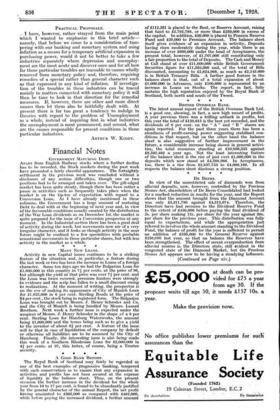The Royal Bank of Scotland may fairly regarded as one
of the best examples of progressive banking, tempered with such conservatism as to ensure that any expansion in activities and profits has not been secured at the expense of liquidity in the balance sheet. Thus, on the present occasion the further increase in the dividend for the whole year from 16 to 17 per cent. is found to be abundantly justified by the general character of the annual Report, the net profit having amounted- to £503,000 as compared with 2482,000, while before paying the increased dividend, a further amount
of £112,561 is placed to the Rest, or Reserve Account, raising that fund to £2,795,788, or more than £259,000 in excess of the capital. In addition, £39,000 is placed to Pension Reserve Fund and £20,000 to Premises Account. The balance sheet itself gives evidence of an expansion in activity, Deposits having risen moderately during the year, while there is an increase of over £600,000 under the head of Acceptances, the present total, however, of £1,767,000 still constituting only nfair proportion to the total of Deposits. The Cash and Money at Call stand at over £11,600,000 while British Government Securities figure for £11,032,000 and, of the total of Bills discounted, amounting to £5,824,968, as much as £2,145.000 is in British Treasury Bills. A further good feature in the
balance is that, out of a total expansion of about £1,000,000 in Advances, only £100,000 is represented by an increase in Loans on Stocks. The report, in fact, fully sustains the high reputation enjoyed -by the Royal Bank of Scotland, both north and south of the Tweed.








































 Previous page
Previous page